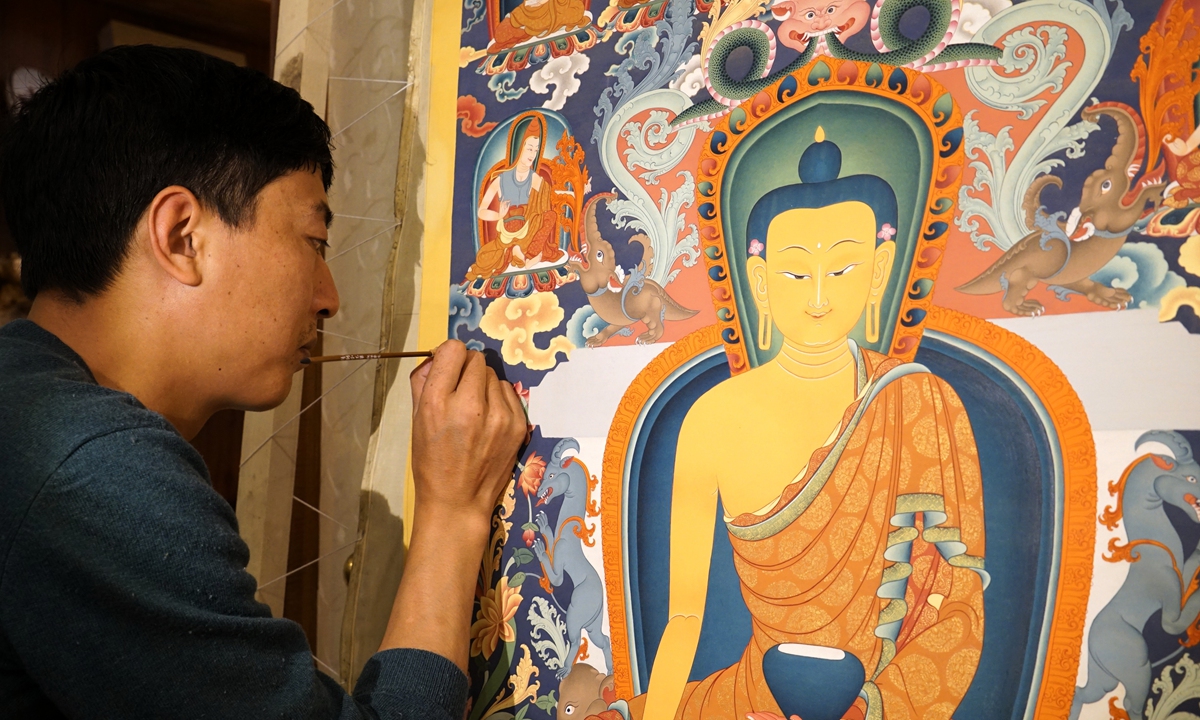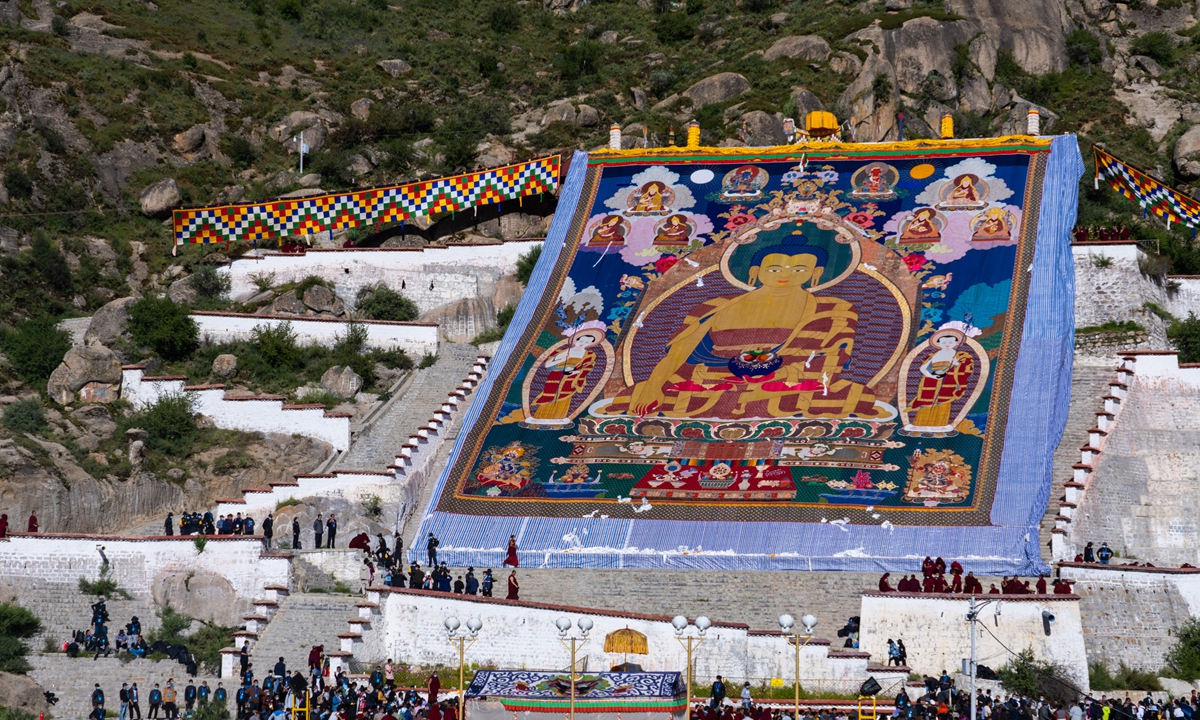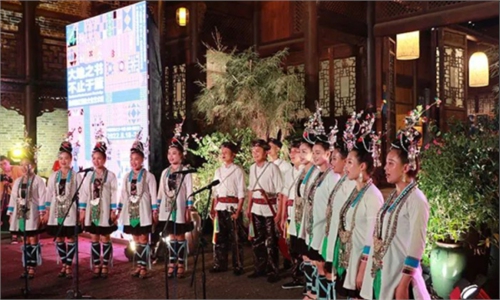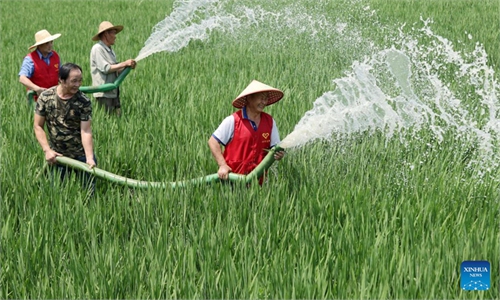ARTS / ART
Painters breathe new vitality into traditional Tibetan art
Living thangka

An artist works on a thangka painting. Photo: Courtesy of Tashi Choedak 
A thangka painting of a giant Buddha on display during the Shoton Festival in Lhasa Photo: VCG
Editor's Note:Every year around the end of August and the beginning of September, the Shoton Festival, one of the most important traditional festivals of Tibetan ethnic group, is held in Southwest China's Xizang Autonomous Region. During the seven-day festival, people eat yogurt, enjoy Tibetan opera, view thangka paintings and enjoy Buddha exhibitions.
From 2006 to 2018, China's central government invested a total of 195 million yuan ($28.26 million) into the protection of Xizang's intangible cultural heritage, which plays an indispensable role in promoting traditional culture.
In this series we will explore these cultural treasures. First comes thangka, traditional Tibetan Buddhist paintings on cotton or silk that are part of these protection efforts. In this article, the Global Times delves further into how artists are creating a place for this ancient art in modern times.
As the first rays of sunlight slip through the window and fall on the traditional thangka paintings in the room, the golden lines around the Buddhist deities shine with halos of light.
For the centuries thangka art was the work of laymen, but this situation changed after the government and locals enhanced the protection of the cultural heritage. Dozens of China's national-level thangka artists were named across the Xizang Autonomous Region to protect the visionary asset, including 37-year-old Tashi Choedak.
Enchanted by tradition
Born into a rather poor herdsmen family in the Garze Tibetan Autonomous Prefecture in Sichuan Province, Tashi Choedak spent most of his childhood digging for caterpillar fungus across 5,000-meter-high mountainous areas, where he would spend nights sleeping in a nearby temple from time to time.
"There were murals, countless stunning murals on the wall inside the temple where I spent my evenings. When I looked at the murals I was enchanted by their colors and would imagine what stories were behind them," said Tashi Choedak.
After learning more about thangka paintings during high school, in 2002 he entered Southwest Minzu University, where he was able to pick up more professional thangka techniques.
Normally on the first day of the Shoton Festival, an approximately 6- or 7-story-high thangka painting of a giant Buddha is displayed on a hillside for local Tibetans to pay homage to.
Yet in addition to its pious religious significance, another point that cannot be denied is its economic value as an art form listed as an intangible cultural heritage in 2006.
"Thangka is not only an inheritance of the splendid culture, but also has huge economic potential. This is a career worth devoting a lifetime to," added Tashi Choedak, who now owns a studio in Lhasa with around 20 students.
Keeping pace
A major representative of traditional Tibetan art, thangka paintings are undergoing modernization in order to stay relevant in today's world.
Statistic shows that there are more than 3,000 thangka artists in the Xizang region and more than 10,000 people in the thangka-derivative industries across cities like Lhasa, Shigatse and Qamdo. The annual average market value of the thangka industry in Xizang has exceeded 200 million yuan, making it an important industry for both the protection and development of this traditional heritage.
On average, it takes two weeks to three months to make a single thangka painting, while a larger one could take more than a decade to make.
In order to drive more people to get involved in this art form, the local government has established an industrial park to regulate the industry.
On average, it takes about five years for a student to complete their studies before they can create their own thangka paintings on their own.
In addition, some thangka painters have begun to incorporate elements of the ocean and culture from southern China to give this ancient art a new twist.
As the art form has gained ground in overseas markets over the past few years, some artists in the region have even begun seeing international demand for their work.
At the Xianhu Thangka Art Center, the largest thangka base in Xizang, artists to fulfill orders from more than a dozen countries such as France, the US and India.
Tashi Choedak told the Global Times that each painting sells for 1,000-10,000 yuan on average, but some of the finer works can go for more than 100,000 yuan.
When all is said and done, thangka artists show an overwhelming dedication to getting things right.
Tashi Choedak told the Global Times that gold foil, agate, pearl, coral, turquoise and other minerals or plants such as saffron, realgar and indigo are used to make the main pigments used to paint a thangka.
"Normally we rely on the local ore industry. But if we can't find the right materials, we drive to an ore production area thousands of miles away to find the right colors we need," he explained.



